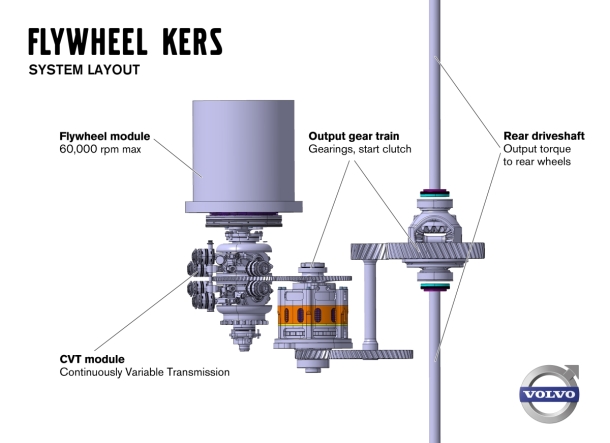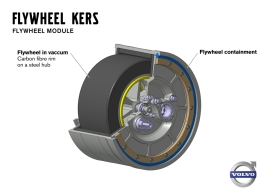Volvo tests flywheel tech to increase fuel economy
Volvo is testing out a new kinetic energy recovery system that has the potential to give cars 20 percent better fuel economy.

Volvo attaches a flywheel through a continuously variable transmission to reduce fuel consumption.
(Credit: Volvo)Ferrari, Renault, BMW, and McLaren have all used kinetic energy recovery systems (KERS) in F1 racing. Now Volvo wants to bring the technology to road cars.
Volvo received a grant from the Swedish government to develop a flywheel-based KERS, and will begin testing it on public roads later this year. The first production Volvos employing this system could become available by 2013.
Similar to a hybrid electric system, KERS stores braking energy, reapplying it to the wheels when the driver calls for acceleration. But Volvo's flywheel system doesn't need batteries. Instead, Volvo fits the flywheel to the rear axle of the car. As the driver brakes, the flywheel spins up, storing the car's forward momentum. A continuously variable transmission connects the rear axle to the flywheel. When the driver accelerates, the flywheel slows as the transmission sends its energy to the rear wheels.
Volvo tested a flywheel system in the 1980s, but found the steel flywheel was too heavy, reducing its efficacy. In the new system, Volvo uses a carbon fiber flywheel weighing 13 pounds. It sits in a vacuum sealed housing to reduce friction, and spins at up to 60,000 rpm, churning out 80 horsepower.
Using a front-wheel-drive car, Volvo's KERS lets the engine shut down when the driver hits the brakes. The engine remains stopped as the car sits at a stop light. When the driver accelerates, KERS provides the initial power, with the gas engine coming back online for power once the flywheel depletes its energy.
Volvo says a car fitted with KERS could leave its engine off for half the time it drives in start-stop or city traffic, cutting fuel consumption by 20 percent. Brake pads would also wear less as the flywheel absorbs the majority of a car's forward motion.

